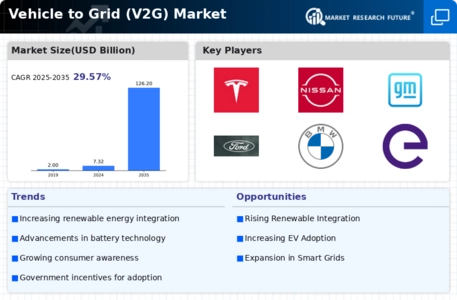Increased Electric Vehicle Adoption
The surge in electric vehicle (EV) adoption is significantly influencing the Vehicle to Grid (V2G) Market. With more consumers opting for EVs, the potential for V2G technology to facilitate energy exchange between vehicles and the grid becomes increasingly relevant. As of 2025, it is estimated that EV sales will surpass 10 million units annually, creating a substantial opportunity for V2G systems to contribute to grid stability. This growing fleet of EVs can provide ancillary services, such as frequency regulation and demand response, which are essential for maintaining grid reliability. The interplay between EV adoption and V2G technology is likely to reshape energy consumption patterns and enhance the resilience of energy infrastructure.
Environmental Sustainability Initiatives
The growing emphasis on environmental sustainability initiatives is a key driver for the Vehicle to Grid (V2G) Market. Governments and organizations worldwide are increasingly prioritizing the reduction of carbon emissions and the promotion of clean energy solutions. V2G technology aligns with these sustainability goals by facilitating the use of renewable energy sources and reducing reliance on fossil fuels. As of 2025, it is anticipated that investments in sustainable energy projects will reach USD 300 billion, reflecting a strong commitment to environmental stewardship. The integration of V2G systems not only supports the transition to cleaner energy but also empowers consumers to actively participate in energy management, thereby fostering a culture of sustainability.
Technological Advancements in Smart Grids
Technological advancements in smart grid infrastructure are propelling the Vehicle to Grid (V2G) Market forward. Smart grids enable two-way communication between utilities and consumers, facilitating the integration of V2G systems. These advancements allow for real-time data exchange, optimizing energy distribution and consumption. As of 2025, investments in smart grid technologies are projected to exceed USD 100 billion, underscoring the commitment to modernizing energy systems. The synergy between smart grids and V2G technology enhances grid management capabilities, enabling utilities to better respond to fluctuations in energy demand. This integration is likely to foster a more sustainable energy ecosystem, where V2G systems play a vital role in balancing supply and demand.
Rising Demand for Energy Storage Solutions
The increasing demand for energy storage solutions is a pivotal driver for the Vehicle to Grid (V2G) Market. As renewable energy sources, such as solar and wind, become more prevalent, the need for efficient energy storage systems intensifies. V2G technology allows electric vehicles (EVs) to act as mobile energy storage units, providing grid support during peak demand periods. According to recent data, the energy storage market is projected to reach USD 200 billion by 2026, indicating a robust growth trajectory. This trend suggests that the integration of V2G systems could play a crucial role in stabilizing energy supply and demand, thereby enhancing the overall efficiency of the energy grid.
Economic Incentives for Renewable Energy Adoption
Economic incentives for renewable energy adoption are significantly impacting the Vehicle to Grid (V2G) Market. Governments are implementing various financial mechanisms, such as tax credits and rebates, to encourage the adoption of renewable energy technologies, including V2G systems. These incentives are designed to lower the initial costs associated with EVs and V2G infrastructure, making them more accessible to consumers. As of 2025, it is estimated that government incentives will contribute to a 30% increase in the adoption of V2G technologies. This financial support not only accelerates the deployment of V2G systems but also enhances the overall attractiveness of renewable energy solutions, thereby driving market growth.


















Leave a Comment